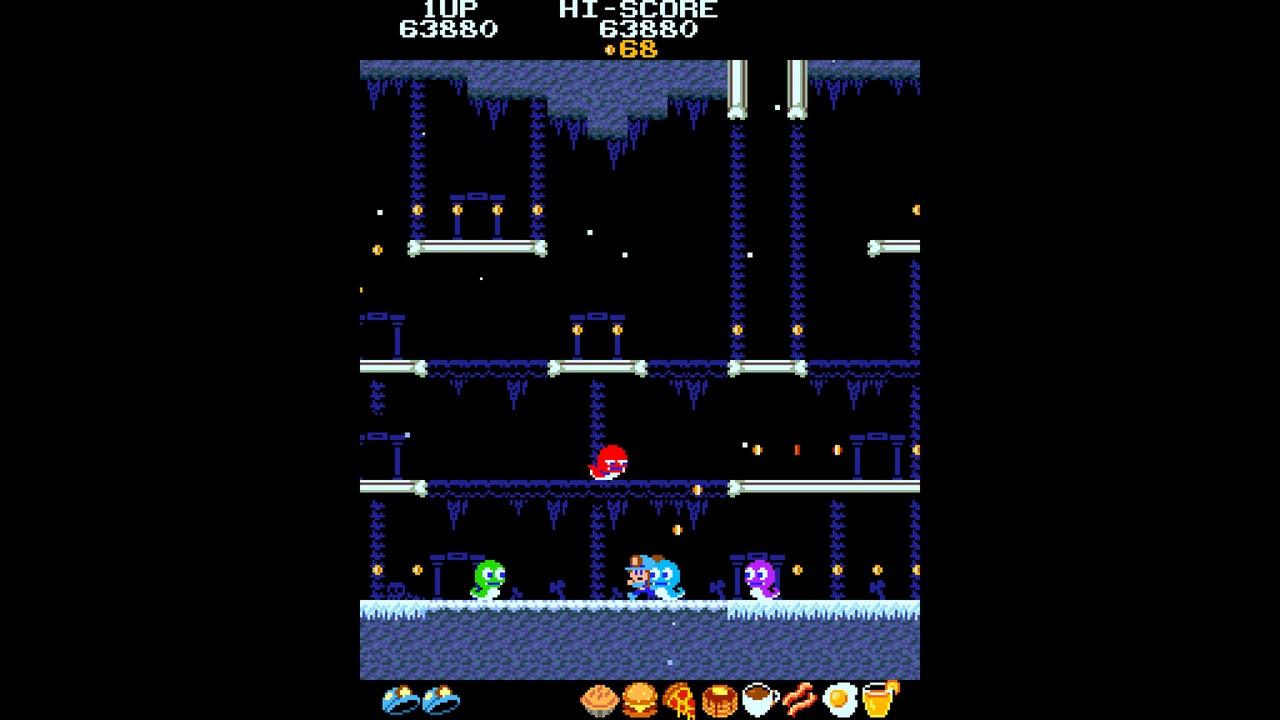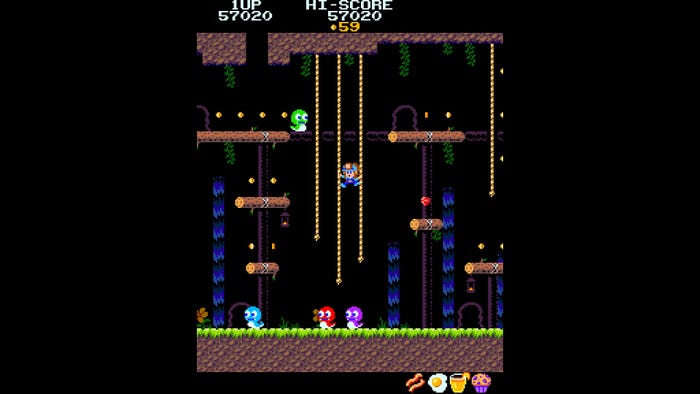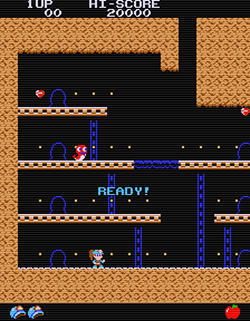Trending
Opinion: How will Project 2025 impact game developers?
The Heritage Foundation's manifesto for the possible next administration could do great harm to many, including large portions of the game development community.

Annalynn is a retro-themed action game made in the style of the classic arcade. The player controls Annalynn on her quest to grab all the coins in each horizontally scrolling level. Opposing her is the Venom Brigade, a group of four snakes with different personalities who duck and ambush their way through the level using caves and ledges, as Annalynn jumps over her enemies and collects Blinding Rubies, stunning them and allowing her to kick them out of the level.
Annalynn has charming music and pixel art graphics, and looks like it came right out of Namco around the time they were making Mappy. As with Donut Dodo, it’s an appealing and enduring action game style. We talked with its creator about the game and its design inspirations.
Who are you, and what is Annalynn?
Hi! I'm Cruise Elroy, a game developer with a particular interest in arcade games from the 1980s. They may have been before my time, but that doesn't mean I love 'em any less. Annalynn is my tribute to some of my favorite games from that era, and even some from after that time! While Annalynn does call back to the difficulty of arcade games from decades ago, it's also a game that I want to be accessible by many without requiring a huge demand for skill. Basically, if you're new to arcade-styled games, start with Annalynn.
Video and computer games today, even indie ones, have different design attributes now than in the classic days of arcades. Maybe it’s just my age showing, but I feel like there’s something about Pac-Man, as an example, that immediately suggests video game in a way that Call of Duty or Minecraft do not. What appealed to you about making a classic arcade-themed game?
'80s arcade games are a genre I absolutely love, since, to me, it marked a period of innovation that I'd argue we haven't seen since then, probably not even during the N64/PS1 era! It's also an aesthetic that, at least during the time I was developing it, very few other games were trying their hand at—the vast majority of "retro revival" games were replicating the feel of console games rather than arcade games, such as the NES or Game Boy. There were a few developers from this time who were doing arcade-styled games (such as Locomalito, releasing games like They Came From Verminest, Darkula, and Maldita Castilla), but for the most part, not that many people were doing much with this style authentically. It's a genre that I felt wasn't getting as much attention as it deserved, so I wanted to make something that was a tribute to not just one of my favorite games of the time but to the era it came from as a whole. Plenty of new games today are embracing this style, and that makes me happy to see!
What would you say are the essential elements of a classic-styled arcade game?
I feel this is a question with a broad answer! Arcade games came in all sorts of shapes and sizes, some feeling pretty similar to ideas before, while others are entirely in a league of their own. If you ask someone, "What's the best arcade game?" I'm sure you'll get hundreds of different responses.
That being said, I think two factors are more important than anything when making a classic arcade game that feels faithful. First, every successful game from this time period had an incredibly simple idea you could understand just by looking over someone's shoulder and watching them play. In Space Invaders, you know to dodge alien lasers and fire right back at them. In Donkey Kong, you know to jump over barrels rolling downwards and climb to the top of the stage. In Pac-Man, you know to eat as much as you can in the maze while outsmarting your adversaries. There are some exceptions, but almost all of these games start the instant you put in a quarter, so getting players to do exactly what they need to do from the word "go" is very important.
Second, that simple idea needs to be easy to understand yet highly replayable. You can technically "beat" Donkey Kong in just 2 minutes by rescuing Pauline, but that's far from where the game ends—the real meat of the game is seeing just how good you can get at it before you get a game over. And that's because climbing ladders and jumping over barrels is fun on its own. If it weren't fun, or if climbing and jumping was too repetitive or complicated, those two minutes rescuing Pauline would be the stopping point.
Both of these are important to get right, but the second factor was more valuable for me to really refine in Annalynn—even after you beat the final boss and see the credits, there are plenty of other things for the player to come back and do. This simple but strong retention is what keeps the arcade classics fun even all these years later!
I identify three types of extra-life award schemes in classic-era arcade games. There’s the kind that gives one, or on harder settings even no extra lives; there’s the kind that gives out one life at a relatively easy-to-reach point, then more lives after much larger score awards; and there’s the kind that gives out lives regularly. This is a useful indicator of how difficult the developer thinks the game is. Pac-Man, for instance, awards at most one extra life over the entire game, but Atari and Williams games usually award lives at regular intervals. Annalynn is a game of the second category: one extra life is fairly easy to earn, and later ones require significantly more skill and effort to reach. Would you say Annalynn is fairly difficult?
I'd certainly say so! That being said, however, I don't think the lives themselves are the sole definer of Annalynn's difficulty. For players who just want to see what the game has to offer, it's entirely possible to get through the game by using continue after continue, but playing the game this way, of course, doesn't demand a huge amount of skill from the player. Instead, I let them decide how much they want to challenge themselves, and the game will reward them in various ways for continuing to hone their skills and learn the game more thoroughly. The way extra lives are given is one example of a reward like this—the first one earned in a game is pretty easy to get, but earning even more lives will ask for a great deal of points from the player—and the more skilled they are at the game, the easier it is for them to earn those extra lives faster!
So yes, the game is hard, but it's at a difficulty that the player can decide for themselves through their own goals. Whether they want to clear the game with lots of continues or no continues at all, it'll come down to what they find the most fun in the game.

Image via Steam.
I notice that the first three levels are mostly like a maze game, although they allow you to jump over enemies and reach platforms. The second set of levels (Jungle) greatly increases the platforming aspects of the game. How does Annalynn’s difficulty increase through the game? How do you balance the difficulty of a game like that?
There are a few parts where the difficulty increasing is pretty straightforward—the snakes move quicker, they learn new strategies for catching you, and Blinding Rubies slowly become less effective over time. However, the other important factor at play here is how the game's level design changes over time. The first handful of levels are pretty simple, but starting with the second world, things become more dangerous, with bottomless pits having players carefully jump over them, for example. New mechanics are also thrown into the mix to keep players on their toes while also testing different skills you'd use in a platformer. Some of these mechanics wouldn't work as well in a maze game!
I think being able to come up with new ideas for a genre mashup like this is important, but so is knowing when to introduce them. If the ropes were introduced alongside bottomless pits and walls in the very first level, that'd be an awful lot for players to take in, especially when they may not know how the snakes and tunnels work. Platformers are a pretty easy genre for people to pick up, but one with Annalynn's style of progression might not be the most familiar, so it was important to have that be the only challenge the player needs to get accustomed to before opening the gate to other mechanics.
One aspect Annalynn doesn’t copy from classic-era arcade games is death from falling, something that has largely been phased out of platforming, even in games that seek to provide a classic kind of arcade experience. Nintendo themselves seem to have taken the lead in this: in Donkey Kong and Donkey Kong Jr., it’s very easy to take a fatal fall; in Mario Bros., though, there is no fall damage, and that’s largely where 2D platformers have stayed ever since. Annalynn doesn’t do fall damage either. Did you toy with making on-screen falls fatal? Do you ever see this making a comeback?
Believe it or not, it was something I considered all the way back when I was first working on this game in 2016. It was indeed a pretty staple mechanic, but I don't think it's to Annalynn's benefit that much. In the first two Donkey Kong games, your main objective was to advance upwards in a careful manner, and the fall damage mechanic served as a means to (I assume) discourage players from getting too reckless. With Annalynn, sure, you do go up in these levels, but it's not the main direction—going downwards is just as important. Platforming carefully isn't the main focus either, since there are moments where you'll need to be quick on your feet to avoid the snakes, and I ultimately felt as though punishing players for falling from too high upwards was a bit too much.
Who knows? Maybe there's a world out there where I did add fall damage to this game and it worked okay, but I think the game we have now is stronger for not having such a harsh penalty.
Not to give away any of the game’s secrets, but I’m interested in getting some insight into how you implemented the Ais of the snake enemies, Randy (the red one), Handy (blue), Candy (purple) and Mike (green). The similarity to a certain other game’s ghosts is inescapable. They seem to have different personalities in the game, similar to Pac-Man, which mostly seems to determine which caves they come out of in ambushing the player. How did you arrive at their AI routines, and how would you compare them to Pac-Man’s monsters?
In the 2016 prototype, their methods for figuring out how to ambush the player did take inspiration from Pac-Man's ghosts much more closely, and while it was more fun to have a more direct translation of its maze gameplay into a platformer genre this way, it did also highlight the importance of adapting old ideas to fit better in a new context. With the way they first targeted the player, two of them would spend nearly half of their time off-screen and away from the player, which not only made dealing with some of them a bit too easy but also made it frustrating to set up some of their positions for point combos.
For the remake, I instead thought more about the spirit of these AI rules, not the letter of them. The ideas on paper still held up, but the added context of gravity meant these principles should fit accordingly. For instance, a ghost that tended to fake the player out by performing a pincer maneuver with one of the other ghosts could instead target a tunnel above the player's current spot rather than the one on the same plane. A ghost ambushing the player by cutting in front of them can pop into a tunnel when behind the player, rather than giving chase the entire time they remain on their ground level.
There are plenty more Namco references beyond the familiar-looking snakes. Food bonuses, the use of color, the style of the character illustrations, and especially the distinctive style of music, which sounds like it’s coming right out of Namco’s Mappy-era sound hardware, which produced some of the best game music from the time. The whole game is like a lost classic Namco arcade machine. What Namco titles would you call inspirations for Annalynn, and what do you find appealing about them?
There's plenty of non-Namco arcade titles that were also a big inspiration to me, such as Donkey Kong Jr. and BurgerTime, but Namco's titles remain my absolute favorites from the arcade era because of their unmatched charm and quality. Whether it be their hugely popular titles (such as Pac-Man, Mappy, Dig Dug, or Galaga) or their one-and-done, more obscure entries (such as Bosconian, Phozon, or Sky Kid), all of their games are ones you can tell where the developers had their hearts put into it. The thing that especially stands out to me with these (and that I wanted to include in Annalynn) is the way they inject tons of personality into their characters and setting—Pac-Man's intermission cutscenes are the biggest standout example of this. They're not just nameless faces for you to get into the shoes of, and I think that's what kept Namco's catalog in the back of my head for so many years.

From Annalynn '16. Image via Itch.io.
You recently released a prototype of Annalynn on Itch.io, called Annalynn ‘16. It’s telling how much the game has changed from that to the “main” version: the levels have a lot less variety, the music is simpler, and the graphics seem a lot less polished, especially the animation of the snakes entering and leaving caves. What is the history of the prototype, and how did you progress from it to the current version of Annalynn?
When I was first getting into game development as a hobby, I'd visit a handful of forums to either show some stuff I was working on or to discuss game development in general, and one of these forums was hosting its own game jam competition. The requirements were pretty loose, so I thought it was a good way for me to make something smaller in scale. Thus, Annalynn '16 (as it's called today) was born!
A few years later, I was playing through a couple of Namco Museum collections and thought it would be fun to try something like that. The remake for Annalynn was originally not a standalone title, but rather a pack-in with three other games that would be made from scratch. Ultimately, though, I thought it was better to focus on Annalynn exclusively, giving it my full attention and dedicating as much as I could to improving upon it, and I think I made the right call. Being able to look back at what was done well and what could be improved in the original was a huge advantage for me, compared to if I had made an entirely new game instead.
That being said, new ideas are in the works! I have no guarantee for when any of them can be showcased since it's all still in the early days of production, but I'm hoping it's something that people will be looking forward to! In the meantime, anyone who'd like to see my small, non-Annalynn projects is more than welcome to take a look at my Itch.io page.
You May Also Like